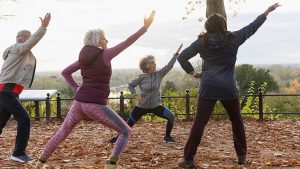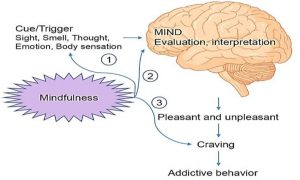Mindfulness is Associated with Better Dementia Patient and Caregiver Outcomes
By John M. de Castro, Ph.D.
“Research has shown preliminary but promising results for mindfulness-based interventions to benefit people with dementia and caregivers.” – Lotte Berk
Dementia is a progressive loss of mental function produced by degenerative diseases of the brain. Dementia patients require caregiving particularly in the later stages of the disease. Caregiving for dementia patients is a daunting intense experience that can go on for four to eight years with increasing responsibilities as the loved one deteriorates. This places tremendous psychological and financial stress on the caregiver. Hence, there is a need to both care for the dementia patients and also for the caregivers. Mindfulness practice for caregivers has been shown to help them cope with the physical and psychological demands of caregiving. In addition, mindfulness training has been found to help protect aging individuals from physical and cognitive declines.
In today’s Research News article “The Effect of Baseline Patient and Caregiver Mindfulness on Dementia Outcomes.” (See summary below or view the full text of the study at: https://www.ncbi.nlm.nih.gov/pmc/articles/PMC8324319/ ) Innis and colleagues recruited patients with dementia and their caregivers and both were measured for cognitive function, functional activities, health related quality of life, verbal learning, memory, executive function, visual ability, mindfulness, resilience, vulnerability, and Apolipoprotein E. In addition, “caregivers completed ratings of care confidence, care preparedness, burden, mood, and appraisals of caregiving”. Finally, a subset of participants underwent brain scanning with Magnetic Resonance Imaging (MRI).
They found that participants without dementia had significantly higher levels of mindfulness than those with even mild dementia. They also found that the higher the level of patient mindfulness the lower the caregiver ratings of patient dementia, the higher the ratings of health-related quality of life, and the lower the rated patient impairment, cognitive complaints, anxiety, and depression. In addition, the higher the patient’s level of mindfulness the higher the levels of cognition, verbal learning, memory, visuospatial ability, and resilience and the lower the levels of vulnerability. Finally, the found that the association of patient mindfulness on cognitive ability was mediated by resilience and vulnerability.
These results are based upon correlations and thus causation cannot be determined. Nevertheless, the associations are clear. The degree of mindfulness of dementia patients is associated with better cognitive ability, emotional health, and resilience and lower levels of vulnerability. These latter relationships appear to be the intermediaries between the patient’s mindfulness and their cognitive ability. It has been shown that mindfulness training in normal individuals produces improvements in resilience. This suggests that mindfulness may help protect against cognitive decline by improving the patient’s resilience and lessening their vulnerability to the effects of aging. This further suggests the possibility that mindfulness training might help to ameliorate the cognitive decline associated with dementia. It remains for future research to explore these possibilities.
So, mindfulness is associated with better dementia patient and caregiver outcomes.
“Alzheimer’s disease patients who practice mindfulness may have better outcomes than those who do not.” – Josh Baxt
CMCS – Center for Mindfulness and Contemplative Studies
This and other Contemplative Studies posts are also available on Google+ https://plus.google.com/106784388191201299496/posts and on Twitter @MindfulResearch
Study Summary
Innis, A. D., Tolea, M. I., & Galvin, J. E. (2021). The Effect of Baseline Patient and Caregiver Mindfulness on Dementia Outcomes. Journal of Alzheimer’s disease : JAD, 79(3), 1345–1367. https://doi.org/10.3233/JAD-201292
Abstract
Background:
Mindfulness is the practice of awareness and living in the present moment without judgment. Mindfulness-based interventions may improve dementia-related outcomes. Before initiating interventions, it would be beneficial to measure baseline mindfulness to understand targets for therapy and its influence on dementia outcomes.
Objective:
This cross-sectional study examined patient and caregiver mindfulness with patient and caregiver rating scales and patient cognitive performance and determined whether dyadic pairing of mindfulness influences patient outcomes.
Methods:
Individuals (N = 291) underwent comprehensive evaluations, with baseline mindfulness assessed using the 15-item Applied Mindfulness Process Scale (AMPS). Correlation, regression, and mediation models tested relationships between patient and caregiver mindfulness and outcomes.
Results:
Patients had a mean AMPS score of 38.0 ± 11.9 and caregivers had a mean AMPS score of 38.9 ± 11.5. Patient mindfulness correlated with activities of daily living, behavior and mood, health-related quality of life, subjective cognitive complaints, and performance on episodic memory and attention tasks. Caregiver mindfulness correlated with preparedness, care confidence, depression, and better patient cognitive performance. Patients in dyads with higher mindfulness had better cognitive performance, less subjective complaints, and higher health-related quality of life (all p-values<0.001). Mindfulness effects on cognition were mediated by physical activity, social engagement, frailty, and vascular risk factors.
Conclusion:
Higher baseline mindfulness was associated with better patient and caregiver outcomes, particularly when both patients and caregivers had high baseline mindfulness. Understanding the baseline influence of mindfulness on the completion of rating scales and neuropsychological test performance can help develop targeted interventions to improve well-being in patients and their caregivers.
https://www.ncbi.nlm.nih.gov/pmc/articles/PMC8324319/









